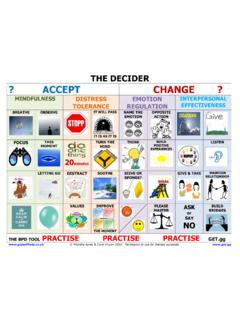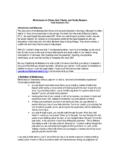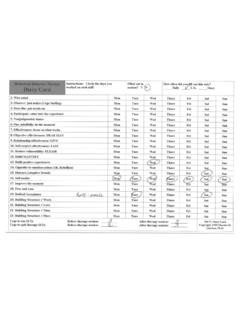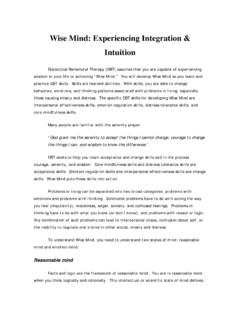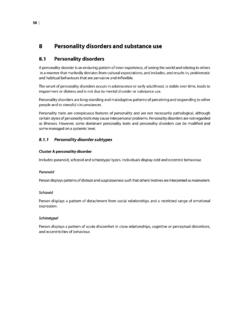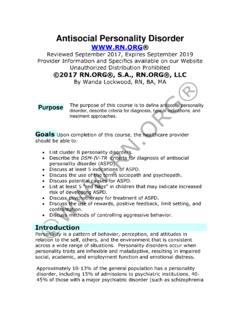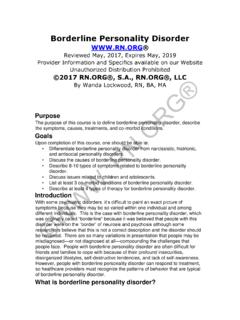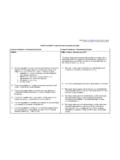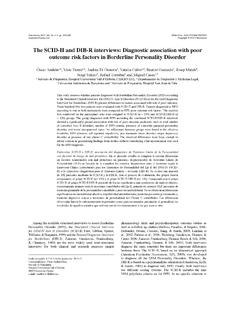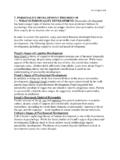Transcription of Borderline Personality Disorder (BPD) Facts Sheet
1 Borderline Personality Disorder (BPD) Facts Sheet WHAT IS Borderline Personality Disorder (BPD)? BPD is an Axis II Personality Disorder characterized by a pervasive inability to regulate emotions and control behaviors linked to emotions. Intense negative emotions commonly include depression, anger, self-hatred, and hopelessness. PREVALENCE OF BPD. BPD occurs in to of the general population, in 8 to 11% of psychiatric outpatients1 2 and 14 to 20% of inpatients. 3 4. SUICIDAL BEHAVIORS ARE VERY COMMON AMONG I NDIVIDUALS WITH BPD. m Suicide is among the top ten causes of death in the United States and in the world. Up to 40% of those committing suicide meet clinical criteria for a Personality Disorder at the time of their death. An even higher percentage of those attempting suicide have a Personality Disorder . The Personality Disorder most associated with both completed and attempted suicide is BPD.
2 M BPD is the only DSM-IV diagnosis for which parasuicide ( , suicide attempts and/or other intentional, non-fatal, self- injurious behaviors) is a criterion and parasuicide is thus considered a hallmark of BPD. m Rates of parasuicide among patients diagnosed with BPD range from 69 to 80%.5 6 7. m Rates of suicide among all individuals meeting criteria for BPD (including those with no parasuicide) is 5 to 10% and double that when only those with a history of parasuicide are BPD INDIVIDUALS ARE HIGH UTILIZERS OF SERVICES AT COMMUNITY MENTAL HEALTH AGENCIES . m Between 6 to 18% of all persons admitted to inpatient psychiatric treatment account for 20 to 42% of all 10 11 12 13 14. m Seventy-five to 80% of inpatient treatment dollars are spent on 30 to 35% of patients receiving inpatient treatment services. m People with BPD are commonly among the highest utilizers of inpatient psychiatric services.
3 Between 9 to 40% of high utilizers of inpatient psychiatric services are diagnosed with 16 17 18 19. BPD IS A CHRONIC DEBILITATING PROBLEM. m Follow-up studies consistently indicate the diagnosis of BPD is a chronic condition, although the number of individuals who continue to meet diagnostic criteria slowly decreases over the life span. m Two to three years after index assessment, 60 to 70% of patients continued to meet Other follow-up studies found little change in level of functioning and consistently high rates of psychiatric hospitalization over two to five 22 Four to seven years after index assessment, 57 to 67% of patients continued to meet 24 An average of 15. years after index assessment, 25 to 44% continued to meet 26. ACHIEVING TREATMENT SUCCESS WITH BPD HAS BEEN NOTORIOUSLY DIFFICULT. m BPD has been associated with worse outcome in treatments of Axis I disorders including major depression,27 OCD,28.
4 Bulimia,29 30 and substance m Follow-up studies of BPD individuals who have received standard community-based inpatient and outpatient psychiatric treatment demonstrate that traditional approaches are marginally effective at best when outcomes are measured two to three years following treatment. m In studies investigating pharmacotherapy for BPD, drop out rates are commonly very high32 33 and medication compliance has been problematic, with upwards of 50% of clients34 and 87% of therapists reporting medication misuse, including use of overdose as a method of attempting 1. 2002 The Behavioral Technology Transfer Group Please do not reproduce or distribute without permission. 1 Widiger, , & Frances, (1989). Epidemiology, diagnosis, and comorbidity of Borderline Personality Disorder . In A. Tasman, R. E. Hales, & A. J. Frances (Eds.), American Psychiatric Press Review of Psychiatry, Vol. 8. (pp.)
5 8-24). : American Psychiatric Press. 2 Widiger, , & Weissman, (1991). Epidemiology of Borderline Personality Disorder . Hospital and Community Psychiatry, 42, 1015-1021. 3 Kroll, , Sines, , & Martin, K. (1981). Borderline Personality Disorder : Construct validity of the concept. Archives of General Psychiatry, 39, 60-63. 4 Modestin, J., Abrecht, I., Tschaggelar, W., & Hoffman, H. (1997). Diagnosing Borderline : A contribution to the question of its conceptual validity. Archives Psychiatrica Nervenkra, 233, 359-370. 5 Clarkin, , Widiger, , Frances, , Hurt, , & Gilmore, M. (1983). Prototypic typology and the Borderline Personality Disorder . Journal of Abnormal Psychology , 92, 263-275. 6 Cowdry, , Pickar, D., & Davies, R. (1985). Symptoms and EEG findings in the Borderline syndrome. International Journal of Psychiatry Medicine, 15, 201-211. 7 Gunderson, (1984). Borderline Personality Disorder .
6 Washington : American Psychiatric Press. 8 Frances, , Fyer, , & Clarkin, (1986). Personality and suicide. Annals of the New York Academy of Sciences, 487, 281-293. 9 Surber, , Winkler, , Monteleone, M., Havassy, , Goldfinger, , and Hopkin, (1987). Characteristics of high users of acute inpatient services. Hosp Community Psychiatry, 38,1112-1116. 10 Woogh, (1986). A cohort through the revolving door. Can J Psychiatry, 31, 214-221. 11 Carpenter, , Mulligan, , Bader, , and Meinzer, (1985). Multiple admissions to an urban psychiatric center: A comparative study. Hosp Community Psychiatry, 36, 1305-1308. Geller, (1986). 12 Green, (1988). Frequent rehospitalization and noncompliance with treatment. Hosp Community Psychiatry, 39, 963-966. 13 Hadley, , McGurrin, , Pulice, , and Holohean, (1990). Using fiscal data to identify heavy service users. Psychiatric Quarterly, 61, 41-48. 14 Geller, (1986).
7 In again, out again: Preliminary evaluation of a state hospital's worst recidivists. Hosp Community Psychiatry, 37, 386-390. 15 Widiger, , & Weissman, (1991). Epidemiology of Borderline Personality Disorder . Hospital and Community Psychiatry, 42, 1015-1021. 16 Geller, (1986). In again, out again: Preliminary evaluation of a state hospital's worst recidivists. Hospital and Community Psychiatry, 37, 386-390. 17 Surber, , Winkler, , Monteleone, M., Havassy, , Goldfinger, , & Hopkin, (1987). Characteristics of high users of acute inpatient services. Hospital and Community Psychiatry, 38, 1112-1116. 18 Swigar, , Astrachan, , Levine, , Mayfield, V., & Radovich, C. (1991). Single and repeated admissions to a mental health center. The International Journal of Social Psychiatry, 37, 259-266. 19 Woogh, (1986). A cohort through the revolving door. Canadian Journal of Psychiatry, 31, 214-221. 20 Barasch, A.
8 , Frances, , & Hurt, (1985). Stability and distinctness of Borderline Personality Disorder . American Journal of Psychiatry, 142, 1484-1486. 21 Dahl, (1986). Prognosis of the Borderline disorders . Psychopathology, 19, 68-79. 22 Richman, J., & Charles, E. (1976). Patient dissatisfaction and attempted suicide. Community Mental Health Journal, 12, 301-305. 23 Kullgren, G. (1992). Personality disorders among psychiatric inpatients. Nordisk Psykiastrisktidsskrift, 46, 27-32. 24 Pope, , Jonas, , Hudson, , Cohen, , & Gunderson, (1983). The validity of DSM-III Borderline Personality Disorder : A phenomenologic, family history, treatment response, and long term follow-up study. Archives of General Psychiatry, 40, 23-30. 25 Perry, , & Cooper, (1985). Psychodynamics, symptoms, and outcome in Borderline and antisocial Personality disorders and bipolar type II affective Disorder . In T. H. McGlashan (Ed.), The Borderline : Current empirical research.
9 (pp. 19-41). Washington, : American Psychiatric Press. 26 Tucker, L., Bauer, , Wagner, S., Harlam, D., & Shear, I. (1987). Long-term hospital treatment of Borderline patients: A descriptive outcome study. American Journal of Psychiatry, 144, 1443-1448. 27 Phillips, K. A., & Nierenberg, A. A. (1994). The assessment and treatment of refractory depression. Journal of Clinical Psychiatry, 55, 20-26. 28 Baer, L., Jenike, M. A., Black, D. W., Treece, C., Rosenfeld, R., & Greist, J. (1992). Effect of axis II diagnoses on treatment outcome with clomipramine in 55. patients with obssessive-compulsive Disorder . Archives of General Psychiatry, 49, 862-866. 29 Ames-Frankel, J., Devlin, M. J., Walsh, T., Strasser, T. J., Sadik, C., Oldham, J. M., & Roose, S. P. (1992). Personality Disorder diagnoses in patients with bulimia nervosa: Clinical correlates and changes with treatment. Journal of Clinical Psychiatry, 53, 90-96.
10 30 Coker, S., Vize, C., Wade, T., & Cooper, P. J. (1993). Patients with bulimia nervosa who fail to engage in cognitive behavior therapy. International Journal of Eating disorders , 13, 35-40. 31 Kosten, R. A., Kosten, T. R., & Rounsaville, B. J. (1989). Personality disorders in opiate addicts show prognostic specificity. Journal of Substance Abuse and Treatment, 6, 163-168. 32 Kelly, T., Soloff, , Cornelius, J., George, A., Lis, , & Ulrich, R. (1992). Can we study (treat) Borderline patients? Attrition from research and open treatment. Journal of Personality disorders , 6, 417-433. 33 Soloff, (1994). Is there any drug treatment of choice for the Borderline patient? ACTA Psychiatrica Scandinavica, 89, 50-55. 34 Waldinger, , & Frank, (1989). Clinicians' experiences in combining medication and psychotherapy in the treatment of Borderline patients. Hospital and Community Psychiatry, 40, 712-718.

